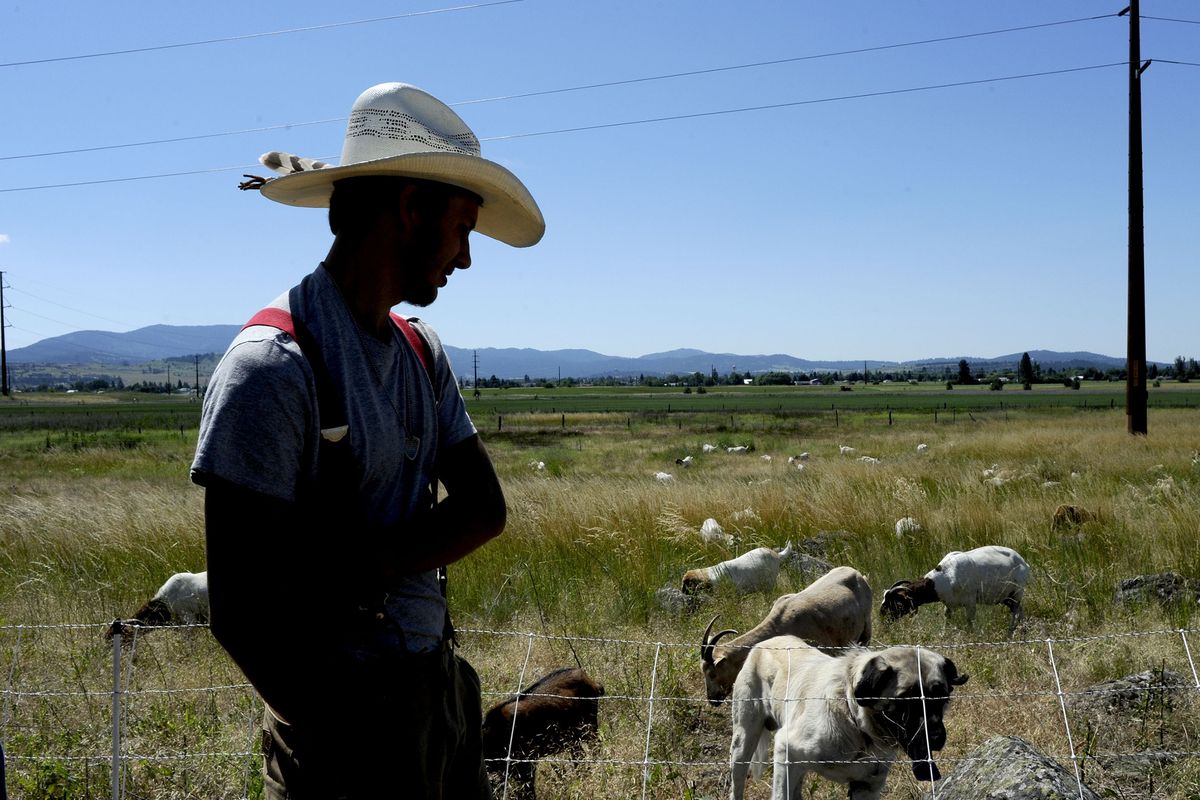An appetite for weeds
Secret weapon against invasive plants may be four-legged and hungry

Seventy-five goats pushed past Reece Dobson as he opened the enclosure to a new area of pasture.
Heads down, they tore into a thorny plant called prickly lettuce. Before they leave the enclosure, the goats will also munch their way through patches of spotted knapweed, dalmatian toadflax and other nonnative, invasive weeds.
“Goats are the greediest livestock on earth,” Dobson, the owner of Goat Pros Organic Weed Control in Nine Mile Falls, said fondly, watching his herd at work.
The goats’ voracious appetites will benefit Avista Corp., which is using them as a pilot project for weed control on 30 acres near a Spokane Valley generating station. Uneven terrain and large rocks make it impractical to mow the acreage. Instead, the goats will act as ruminant lawnmowers, eating through thickets of vegetation that other livestock wouldn’t touch.
Avista will evaluate the project at the end of the season, said Debbie Simock, an Avista spokeswoman. If it’s successful, the pilot could expand to other areas, she said.
Dobson’s company grew out of a 4-H goat project. As his herd increased in size, he got free forage by offering the goats to friends who needed weed control or firebreaks on their property.
Dobson, 20, quickly recognized the commercial potential. For business advice, he turned to Craig and Sue Lani Madsen. They own Healing Hooves in Edwall, Wash., which rents out goats for weed control, mostly in Western Washington.
The Madsens became Dobson’s mentors and hired him as a subcontractor for the Avista project.
Goats are ancient tools for vegetation control, said Craig Madsen, a former rangeland specialist for the federal government. A hard palate and hearty constitution allow them to eat plants that cattle can’t stomach.
Goats can control weeds on steep slopes, streamside corridors and other places where mowing, hand crews or chemical spraying aren’t practical, Craig Madsen said. The cost of using goats varies, but Healing Hooves charges about $250 to $400 per acre for projects in Eastern Washington.
Clients also get an added benefit from the goats, said Sue Lani Madsen: “Time-release organic fertilizer.”
The Madsen and Dobson herds are a Boer-Kiko crossbreed – a mix of South African and New Zealand breeds that produce hearty goats with good mothering instincts.
Each adult eats about 8 to 12 pounds of vegetation per day. Goats are browsers, preferring bushy greens to grasses. By monitoring their grazing, herders can manipulate which plants the goats eat, leaving the preferred plants.
Someone stays with the goats around the clock. Dobson lives in a camper at the Spokane Valley site. His companion is Gus, a herding dog.
“I love it, myself,” Dobson said of the solitary hours spent keeping an eye on the herd. “At 20, you’re supposed to go out and have a lot of fun.”
But Dobson always knew he wanted to work with animals. Each goat in his herd has a name. “That’s Shannon. We call her the White Buffalo, ” he said, pointing to a particularly well-fed goat.
Dobson’s grandfather, a Moses Lake cattle rancher, was initially skeptical when he heard about his business plan. He couldn’t believe people would rent a herd of goats to eat weeds, Dobson said.
It’s a new way of thinking for traditional livestock owners, said Sue Lani Madsen. She and her husband are interested in finding ways to integrate farming into metro areas.
In Seattle, their clients include homeowners associations, who need help clearing blackberries out of ravines or thistles out of undeveloped “natural areas.”
“There’s a lot of land that can benefit from the impact of animal grazing,” she said.